How to Level an Uneven Lawn – A Step-by-Step Guide
If your lawn no longer appears as smooth and even as it once did, it may be time to level it. Uneven patches can develop over time due to different factors, including soil settling, drainage problems, or other natural changes.
An uneven lawn isn’t just unattractive—it can pose safety risks and lead to additional damage. On the other hand, an adequately leveled lawn enhances the overall appearance of your yard and makes maintenance much more straightforward.
In the following lines, learn about the common causes of an uneven lawn, practical approaches, how to assess the severity, and step-by-step methods to fix it.
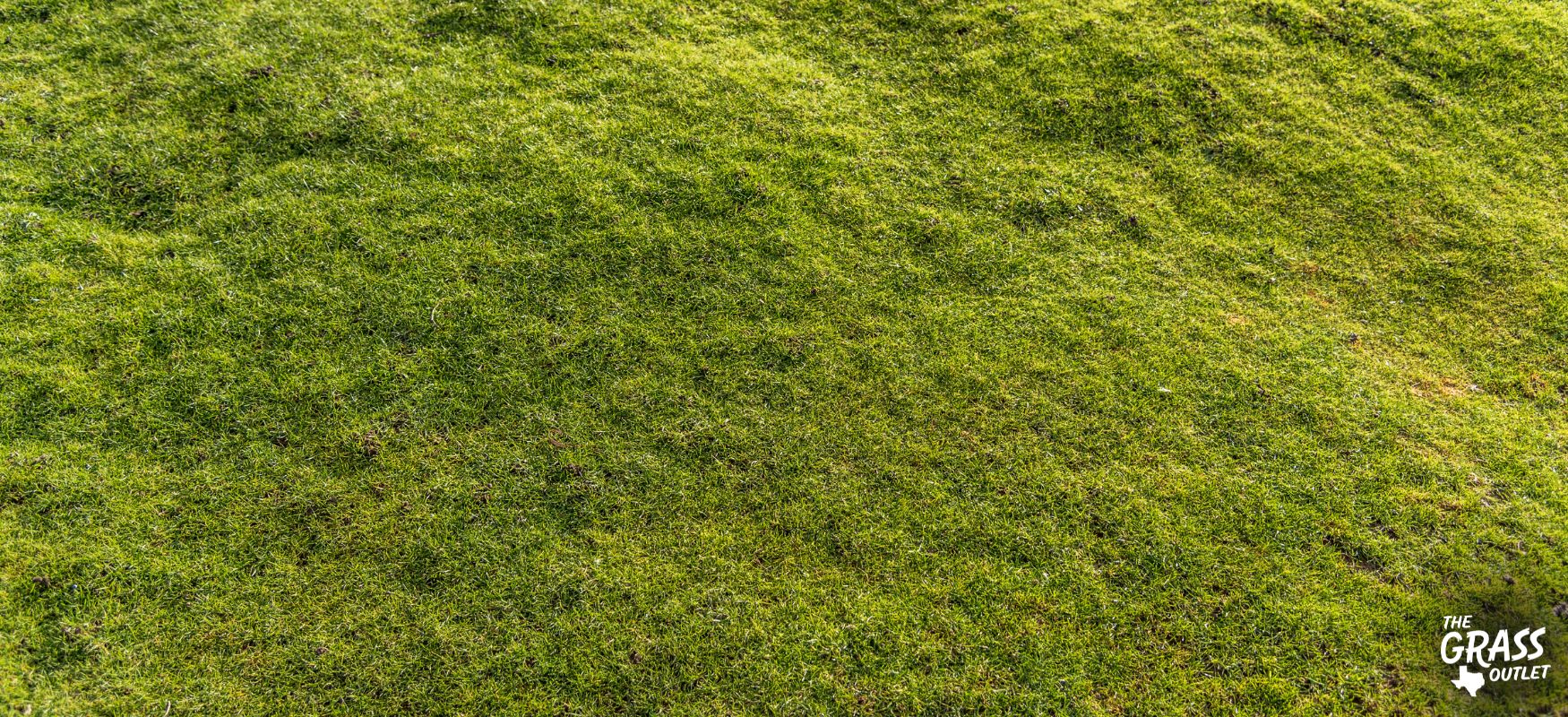
Why Do Lawns Become Uneven?
Understanding why uneven lawns develop over time helps you identify the best strategies for treating the problem. They could be uneven due to many issues, including one or more of the following:
- Natural Soil Settling: As the years pass, soil naturally shifts and settles, leading to uneven areas with bumps and dips.
This process isn’t uniform—factors like erosion, compaction, and natural ground movement can cause certain spots to sink while others remain raised. Additionally, tree roots or buried objects beneath the surface can contribute to unevenness as the soil compresses and adjusts over time. - Heavy Foot Traffic or Pet Activity: Constant pressure compacts the soil unevenly. Lawns provide an excellent play space for children and pets, but running, jumping, or even walking on wet soil can lead to compaction, creating uneven spots and drainage issues. This not only affects the health of your grass but can also cause long-term problems for the soil structure. Repeated pressure from people and pets compresses the soil over time. In high-traffic areas, this compaction becomes even more severe—resulting in dips, ruts, and an uneven lawn surface.
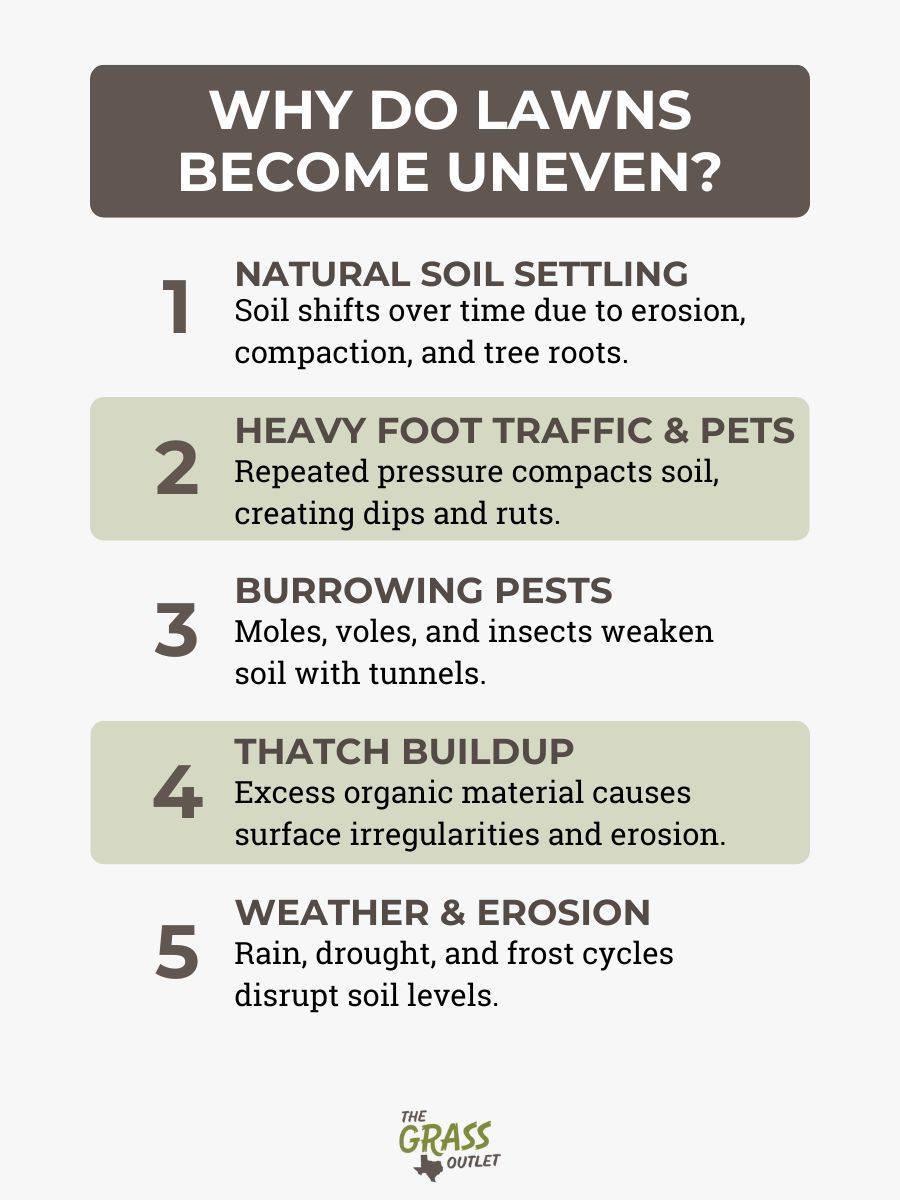
- Burrowing Pests: Moles, voles, or insects can create underground tunnels.
Wildlife, from burrowing moles to foxes scavenging for food, is a major contributor to uneven lawns. These animals often wander into your garden, especially during seasons when your lawn is most vulnerable. The underground tunnels they create weaken the soil structure. These burrows not only lead to uneven surfaces but can also disrupt grassroots, making it harder for your lawn to stay healthy. - Thatch Buildup: Excessive thatch can cause surface irregularities. Thatch is a layer of organic material that forms above the soil, protecting the grass’s roots. Ideally, it remains between ¼ and 1/2 inch thick, consisting of matted, decomposing grass clippings and older grass plants. However, when a lawn is weakened by issues like thinning grass, insect infestations, or disease, the grass blades die off first, followed by the rapid decomposition of the thatch. This exposes bare soil, which becomes more vulnerable to rain, wind, and foot traffic erosion. As the soil erodes, it creates depressions that leave the lawn uneven compared to surrounding healthier areas.
- Weather & Erosion: Heavy rain, drought, or frost heaving can create depressions. Severe weather conditions, such as heavy rainfall or drought, can significantly affect soil consistency and contribute to lawn unevenness. During winter, repeated freezing and thawing cycles cause the soil to expand and contract, redistributing it unevenly. This process can create raised areas in some spots while leaving others noticeably lower.
Too much water causes soil to clump together, forming bumps when it dries, while insufficient moisture leads to desiccation, cracking, and rutting.
Poor drainage further exacerbates these issues by causing waterlogging, which deprives the soil of oxygen and essential nutrients. If left unaddressed, standing water can compact the soil, damage roots, and hinder aeration, resulting in an uneven lawn with inconsistent growth.
Assessing Your Lawn’s Unevenness
A healthy lawn starts with healthy soil. Compacted soil can lead to excessive weed growth, restrict root expansion, and prevent essential nutrients from reaching the grass. Left untreated, it can slow down lawn growth and cause long-term damage. Identifying uneven areas early allows for timely intervention and effective leveling.
How do we identify problem areas? Start by walking across your yard to pinpoint any irregularities. Feel for dips, soft spots, or raised areas that disrupt the lawn’s smoothness.
Using a lawn roller can highlight problem areas by gently pressing down high spots, making it easier to detect unevenness.
Another common way to check for soil compaction is the screwdriver test. Push a screwdriver into the soil; if you struggle to insert it at least six inches deep (up to the handle), the soil is compacted and may require aeration. Additionally, standing water is a usual indicator of poor drainage, contributing to an uneven lawn if not addressed.
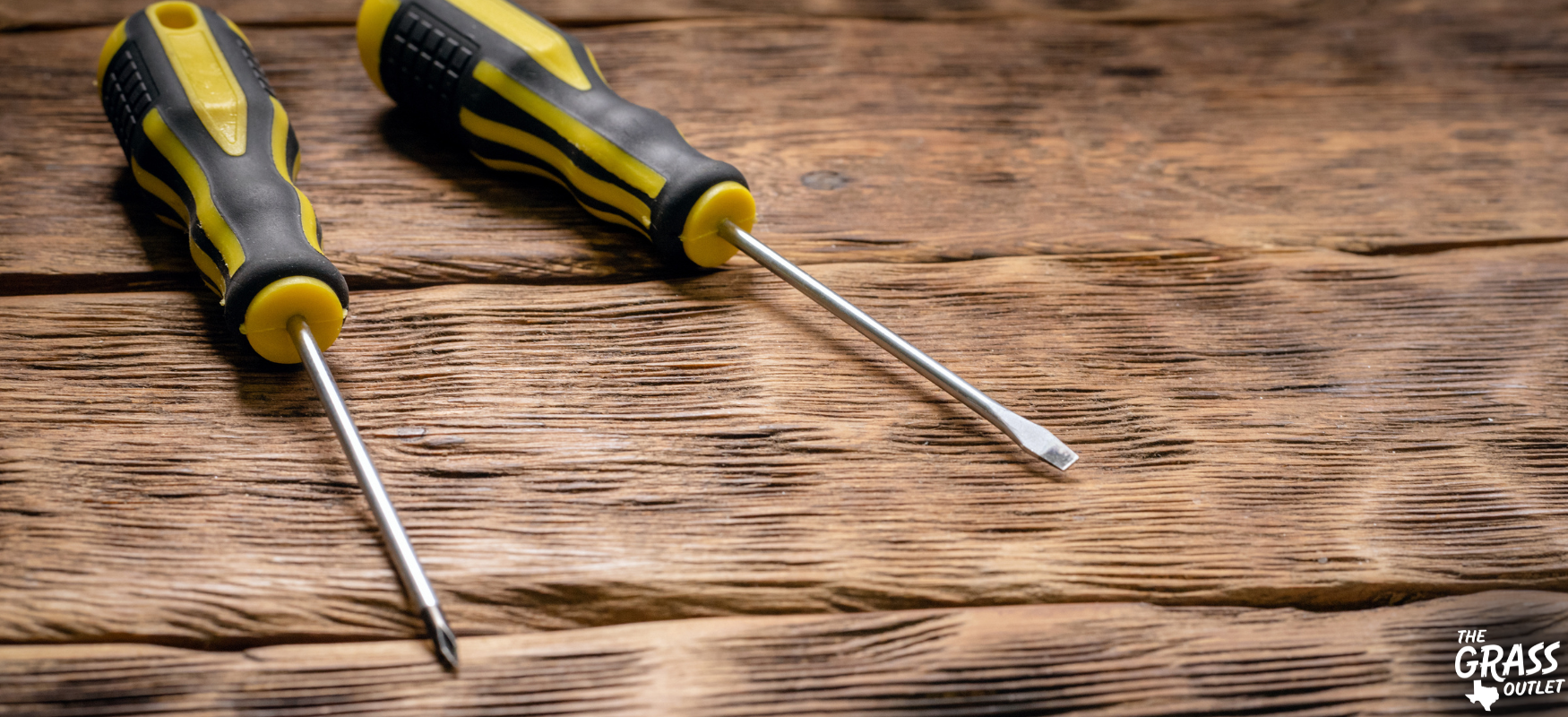
Assessing the extent of your lawn’s unevenness helps determine the level of intervention needed. Experts classify uneven lawns into three categories: mild, moderate, and severe.
Mild unevenness refers to small dips and bumps less than 1 inch deep, typically scattered throughout the lawn. A topdressing mix can easily correct these minor irregularities.
Moderate unevenness—There are more noticeable high and low spots between 1 and 3 inches deep. Fixing moderate unevenness requires extra effort, including adjusting soil levels by adding or removing dirt and using leveling tools such as a garden rake or leveling rake.
Severe Unevenness – Significant depressions or raised areas exceeding 3 inches in depth or height. Correcting this level of unevenness may require excavation, regrading, and major lawn renovations such as sod installation or reseeding.
How to Level a Slightly Uneven Lawn (Topdressing Method)
The topdressing method is an effective and low-effort solution for minor unevenness, such as small depressions and surface irregularities. This DIY approach smooths out your lawn and enhances soil health and drainage. To address these lawn issues, follow these steps:
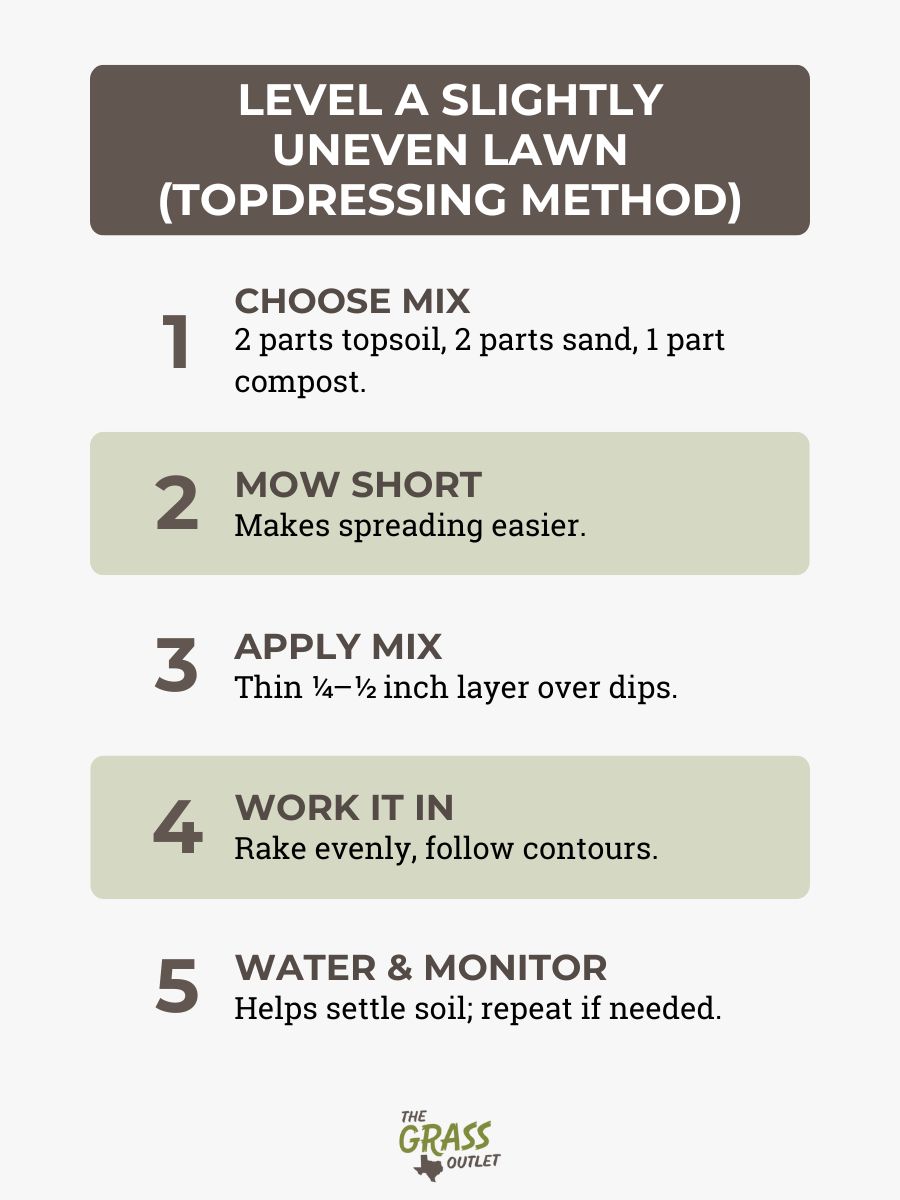
- Choose the Right Leveling Mix
To fill in sunken areas, prepare a balanced topdressing blend using two parts topsoil, two parts USGA spec sand, and one part compost. Sand improves drainage and prevents compaction, while topsoil and compost provide essential nutrients that support healthy grass growth. - Mow the Lawn Short
Before applying the topdressing mix, mow your lawn shorter than usual. This makes spreading and integrating the mixture evenly into the existing grass easier. - Apply the Topdressing Mix
Spread a thin layer of the topdressing blend—about ¼ to ½ inches thick—over the uneven areas. Avoid applying too much at once, as burying the grass can hinder growth. - Work It In
Use a leveling rake, garden rake, or the back of a push broom to distribute the mix evenly across the lawn. This step ensures the soil blends with the existing surface and follows the lawn’s natural contours. A lawn roller filled with water can gently compact the soil for added precision. - Water & Monitor Growth
Lightly water the treated areas to help the soil settle and eliminate air pockets.
Allow the grass to grow through the topdressing before repeating the process if necessary. Over time, this method evens the lawn and improves aeration, drainage, and overall grass health.
How to Fix Deep Depressions (2+ Inches Deep)
For more significant dips and settled areas in your lawn, a more involved approach is required to restore a smooth and even surface. Fixing severe unevenness in your lawn can be complex and labor-intensive, often requiring more than a simple DIY approach. If the damage is extensive, regrading the entire yard may be necessary, particularly in areas where standing water has caused significant sinking.
- Remove the Existing Grass (If Necessary)
If the affected area still has grass, carefully lift the sod using an edging or sod-cutting shovel to preserve it for reinstallation. - Fill the Low Spots with a Quality Soil Mix
Prepare a topsoil and sand blend or a sand-compost mix to improve drainage and soil health. Use a garden rake or leveling rake to spread the mixture evenly into the low areas, ensuring it blends seamlessly with the surrounding lawn. For best results, lightly compact the soil to prevent future settling. - Reinstall Grass or Reseed
Once the surface is level, replace the lifted sod and press it firmly into place. If the area is bare, overseed or re-sod it with the same grass variety to encourage uniform growth. Lightly rake the seeds into the soil to promote good seed-to-soil contact. - Water & Maintain
Keep the area consistently moist to help the grass establish strong roots. Avoid heavy foot traffic until the new grass is well-rooted. Over the following weeks, monitor for settling and reapply soil if necessary to maintain an even surface.
How to regrade?
Proper regrading ensures long-term stability and prevents recurring unevenness. Consulting a professional landscaper may be the best solution for extensive grading needs, such as large sunken areas or persistent drainage issues. If you must do it alone, here is what to pay attention to.
The fundamental rule of grading is that the ground must slope away from your house at a rate of two to three inches every ten feet to promote proper water runoff.
To begin, mark the intended slope using stakes as a guide. Carefully remove the topsoil from problem areas and adjust the subsoil, scraping down high spots and filling in low areas to create a uniform gradient. Once the subsoil is shaped correctly, spread a two-inch layer of topsoil and till it into the first two inches of subsoil to enhance integration and prevent drainage issues.
Then, apply four additional inches of topsoil to create a nutrient-rich foundation for grass growth.
With the final grade established, you can either lay sod for instant coverage or seed the area for gradual lawn development.
How to Level a Bumpy Lawn
Smoothing out a bumpy lawn is a simple yet effective way to improve its appearance and overall health. This method works best for addressing high spots without requiring major excavation.
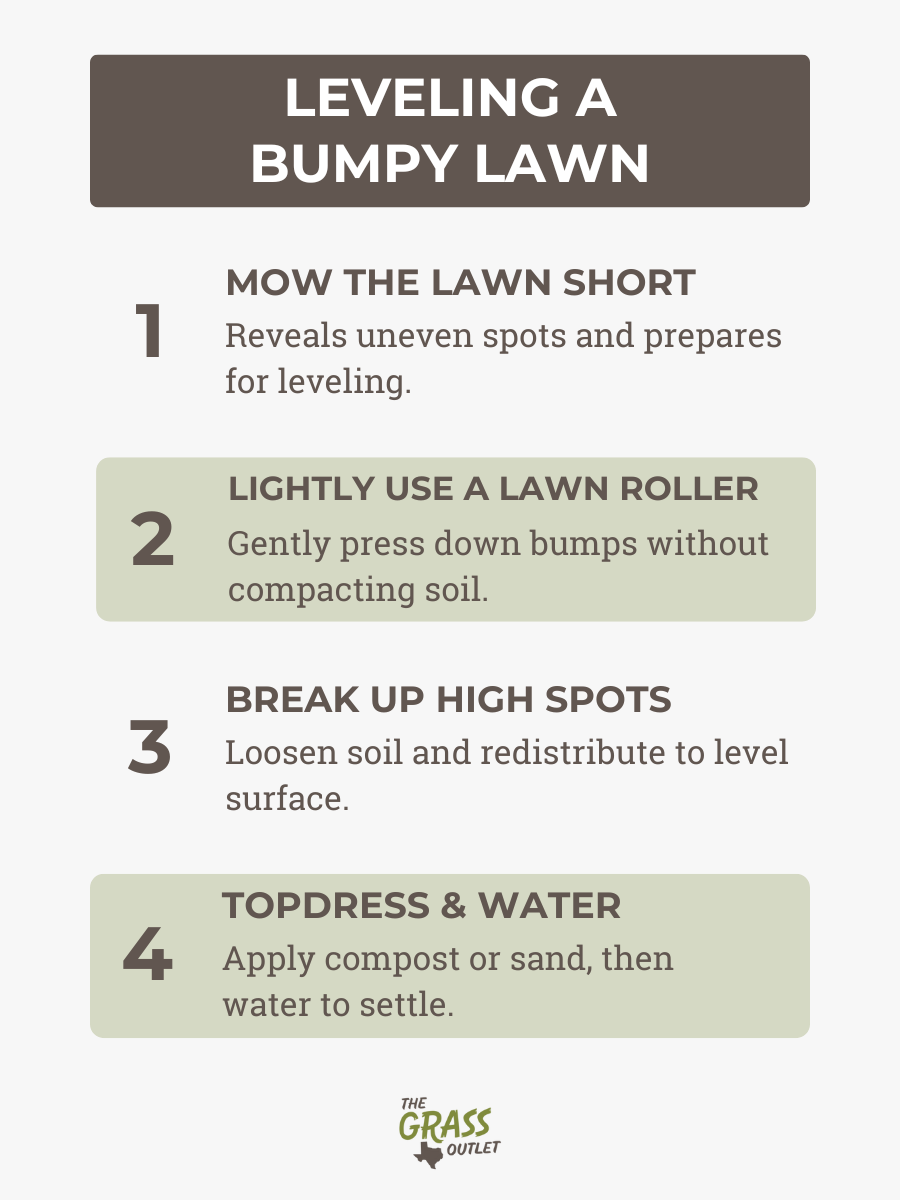
- Mow the Lawn Short:
Start by mowing the grass shorter than usual to reveal uneven areas that need adjustment. - Use a Lawn Roller (Lightly):
Use a lawn roller with a light touch to press down minor bumps. Do not overcompact the soil, as this can lead to drainage issues. - Break Up High Spots:
Break them up for more stubborn high spots with a garden rake or dethatcher, loosening excessive thatch and redistributing the soil to create a more even surface. - Topdress & Water:
Once the bumps have been addressed, apply a thin layer of topdressing material, such as compost or USGA spec sand, to further smooth the area. Water thoroughly to help the new material integrate with the existing soil.
By following these steps, you can achieve a more level, healthier lawn that looks polished and feels comfortable underfoot.
When to Level Your Lawn
Best Time
The ideal time to level your lawn is in spring or early summer when grass is actively growing and can recover quickly. Spring provides the necessary moisture to help settle the soil, but excessive traffic on soft, thawing ground can create new bumps.
Avoid leveling during extreme heat or cold, as grass growth slows in harsh conditions, making a recovery more complex.
Frequency
Minor leveling can be done once a year to maintain an even lawn surface. However, significant corrections should be spaced out to prevent excessive stress on the grass and allow time for healthy regrowth between adjustments.
Common Mistakes to Avoid
When leveling a lawn, avoiding common mistakes is as important as following the proper steps. Here are some of the common mistakes to avoid:
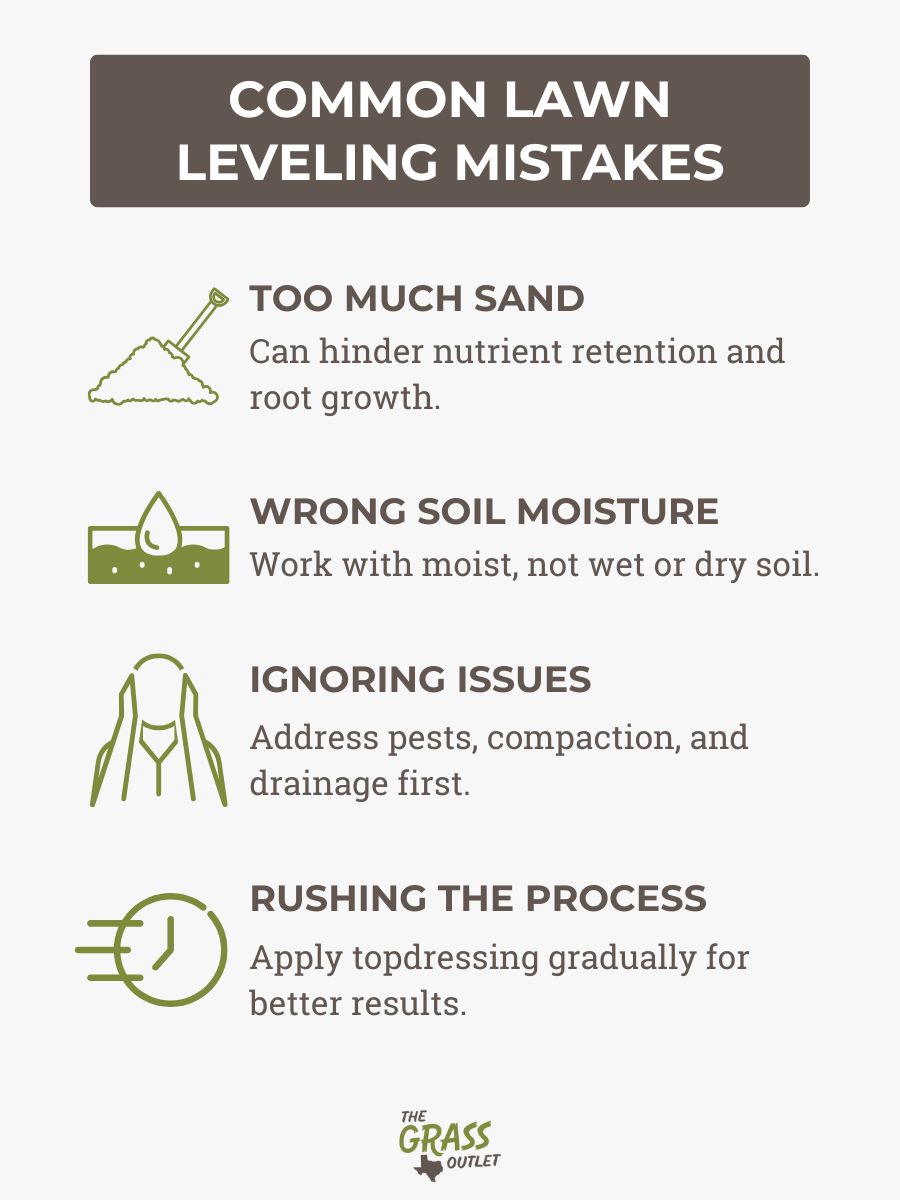
Using Too Much Sand:
This is one of the biggest mistakes when leveling a lawn. While sand can enhance drainage, relying on it too heavily, without mixing it with soil or compost, can lead to poor nutrient retention and restricted root growth. This can result in weak, patchy grass that struggles to thrive.
The ideal leveling mix should be suited to your lawn type and climate, ensuring proper aeration, drainage, and nutrient availability. If unsure, consulting a professional landscaper can help you select the best materials and techniques for long-term lawn health.
Leveling Wet or Dry Soil:
Before beginning the leveling process, ensure the soil is dry. Heavy rainfall can create significant setbacks, making the ground too saturated and difficult to work with. Waterlogged soil becomes dense and challenging to dig, leading to unnecessary complications. For optimal results, work with moist soil but not overly wet.
Ignoring Underlying Issues:
Ignoring underlying issues like pest infestations, soil compaction, or drainage problems can also lead to long-term lawn health problems, so be sure to address these before leveling, as addressing these factors first ensures a stable foundation. Pests like grubs, moles, and voles can create tunnels and weak spots, causing ongoing unevenness if left unchecked.
Compacted soil restricts water, air, and nutrient flow, stunting grass growth—so aerating the lawn beforehand is key. Drainage problems, such as pooling water or erosion, can wash away soil and create further depressions, making it crucial to improve soil composition or install proper drainage solutions.
Rushing the Process:
Finally, don’t rush the process. Allow your grass time to recover and build up the leveling mix gradually rather than applying too much at once. A patient, methodical approach will lead to a smoother, healthier lawn in the long run.
Conclusion
Leveling your lawn is essential to maintaining a healthy and visually appealing outdoor space.
Start by identifying the root cause of unevenness, then follow the appropriate steps to smooth out bumps and fill in low spots. Whether handling minor imperfections or significant depressions, using the proper techniques will ensure lasting results and make future lawn care more manageable.
While some homeowners may enjoy the challenge of a DIY project, others might find it beneficial to hire a professional who can accurately assess the problem and provide a customized solution. The Grass Outlet has high-quality sod and professional expert guidance to help you address uneven lawn issues and achieve a smooth, well-balanced lawn.





